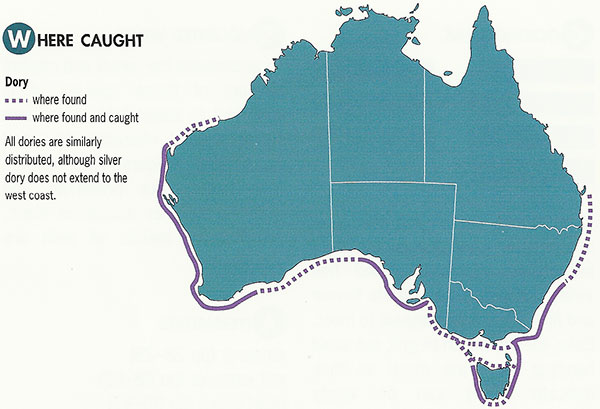Dories have succulent, white, sweet and finely textured flesh.
They can be baked, grilled, barbecued, fried, steamed or poached.
Dory fillets are delicate and often best coated or wrapped in foil for cooking.
Catch limits
| Catch limit | Fishing Mortality* | Biomass** |
|---|---|---|
Catch Limit (Incidental) 60 tonnes For the 2025–26 Season | Y;Uncertain | R;Overfished |
* Fishing mortality status relates to the level of fishing pressure on a stock – specifically, whether fishing mortality in the year being assessed is likely to result in the stock becoming overfished or prevent the stock from rebuilding from an overfished state. If fishing mortality exceeds either of these thresholds, a stock is considered to be subject to overfishing.
** Biomass status relates to how many fish there are – specifically, whether the biomass in the year being assessed is above the level at which the risk to the stock is considered to be unacceptable. The HSP defines this level as the limit reference point, below which the stock is considered to be overfished.
Scientific name: Zeus faber
Family: Zeidae
Other names: St Peter’s fish
Description: John dory have highly compressed plate-like bodies with large heads and large mouths. They are silvery to olive-green, with a blue-black spot surrounded by a yellowish ring on each side of the body. John dory often also have darker, wavy lines on the body. The scales are very small. The fins are spiny and dusky coloured.
Size (length and weight): Up to about 65 cm in length and 3 kg. Commonly found at 30‑45 cm in length and 0.5‑1.5 kg. Females grow larger than males.
Life span: Up to 15 years. Females live longer than males.
Habitat: John dory are a demersal species that lives close to the sea bed in coastal and continental shelf waters. They can be found to depths of 200 metres. John dory are considered to have a locally patchy distribution and use a variety of habitats including open sand, muddy grounds, rock structures and reefs. John dory are generally solitary.
Prey: Fish, crustaceans, molluscs and occasionally cephalopods.
Predators: Sharks, large bony fish and potentially marine mammals such as dolphins.
Reproduction: John dory reach reproductive maturity at 3‑5 years of age. They are known to spawn off the coast of New South Wales in late summer and autumn. John dory spawn multiple times during the spawning season. Fecundity has not been estimated, but is thought to increase with body size.
Other notes: Known as kuparu in New Zealand.
| Fishery | Gear | Catch of this species is targeted or incidental |
|---|---|---|
| Southern and Eastern Scalefish and Shark Fishery – Commonwealth Trawl Sector | Bottom trawl, danish seine | Incidental |
John dory are predominantly caught incidentally using trawl and danish seine in the Commonwealth South East Trawl Sector.
The Commonwealth catch of John dory is managed by quota. This means the catch of this fish by commercial fishers is restricted by weight. AFMA also restricts the number of boats and the type and amount of gear that can be used to fish for John dory.
John dory was assessed as overfished in 2021. Since then, AFMA has implemented management arrangements to reduce the total catch, including significantly reduced TACs, and from 1 May 2023 will implement a network of closures along the east coast aimed at constraining catches of at-risk species. A formal rebuilding strategy for John dory will be developed during 2023.
Commercial fishermen are required to fill in records of their catches, during each fishing trip and when they land their catch in a port. This helps us keep records of how much is being caught.
AFMA decide on the amount that can be caught each year from expert advice and recommendations from fisheries managers, industry members, scientist and researchers.
John dory are found from south eastern Queensland, around the south of the country, and north to the central coast of Western Australia, however most catch is taken off New South Wales and eastern Victoria.
They can be found year round from shallow inshore waters to a depth of about 400 metres.

Bottom trawl and danish seine are the main fishing method used to catch John dory.
The impact of bottom trawl on bycatch species and habitats has been assessed as part of the ecological risk assessments. AFMA mitigates, or reduces, that impact through its ecological risk management strategy. The strategy details a number of management arrangements and strategies which aim to reduce the impact of fishing on the environment, including:
- minimum mesh sizes for bottom trawls to reduce the catch of small and juvenile fish
- mitigation devices to reduce interactions with threatened, endangered and protected species
- and closing areas to fishing to protect vulnerable species and habitats.
All bottom trawl boats are also required to have a seabird management plan in place to reduce interactions with seabirds during fishing.
Gear
Want to know more?
This is just an overview of John dory, if you want to know more see the links below.
This fish is managed under the Southern and Eastern Scalefish and Shark Fishery.